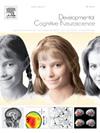Differential microstructural development within sensorimotor cortical regions: A diffusion MRI study in preterm and full-term infants
IF 4.9
2区 医学
Q1 NEUROSCIENCES
引用次数: 0
Abstract
The sensorimotor system develops early in utero and supports the emergence of body representations critical for perception, action, and interaction with environment. While somatotopic protomaps are already developed in the primary somatosensory and motor cortices in late pregnancy, little is known about the anatomical substrates of this functional specialization. In this study, we aimed to decipher the microstructural properties of these regions in the developing brain. Using advanced diffusion MRI and post-processing tools, we parcellated the pre- and post-central gyri into microstructurally distinct clusters along the lateral-to-medial axis in 25 full-term neonates, confirming the early differentiation within sensorimotor regions. These clusters were further analyzed in 59 preterm infants scanned at term-equivalent age (TEA, PTTEA), of which 45 were also scanned near birth (PTBirth), and compared with another group of 59 full-term neonates. Applying a multivariate Mahalanobis distance approach, we quantified deviations in preterm cortical microstructure relative to the full-term reference. Preterm infants showed significant region- and position-specific deviations at both ages, though these were smaller at TEA (repeated-measures ANCOVA: PTBirth: region effect F=25.48, position effect F=16.06; PTTEA: region effect F=14.87, all p < 0.001), consistently with ongoing maturation during the pre-term period. Differences between the pre- and post-central gyri, and along the somatotopic axis, suggested differential vulnerability to prematurity. In particular, compared with somatosensory regions, the motor regions appeared to be at a more advanced stage of maturation close to birth (paired t-test, T = -4.388, p < 0.001) and less vulnerable at TEA (paired t-test, T = -4.169, p < 0.001), suggesting lesser impact of prematurity. An opposite pattern was observed, particularly close to birth, for lateral positions related to mouth representation compared with intermediary (paired t-test: T = 5.933, p < 0.001) and medial (paired t-test: T = 4.712, p < 0.001) positions. These findings support the notion that early sensorimotor cortical specialization is microstructurally emergent during gestation and sensitive to atypical developmental context of preterm birth.
感觉运动皮质区显微结构发育差异:早产儿和足月婴儿弥散MRI研究
感觉运动系统在子宫早期发育,支持对感知、行动和与环境互动至关重要的身体表征的出现。虽然在妊娠后期初级体感觉和运动皮质中已经形成了体位原图,但对这种功能专门化的解剖学基础知之甚少。在这项研究中,我们的目的是破译这些区域在发育中的大脑的微观结构特性。利用先进的弥散MRI和后处理工具,我们在25个足月新生儿中沿外侧至内侧轴将中央后回和中央前回包裹成微观结构上不同的簇,证实了感觉运动区域的早期分化。这些聚类进一步分析了59例足月年龄扫描的早产儿(TEA, PTTEA),其中45例也在临近出生时扫描(PTBirth),并与另一组59例足月新生儿进行了比较。应用多元马氏距离法,我们量化了早产儿皮层微观结构相对于足月参照的偏差。早产儿在两个年龄段都表现出显著的区域和体位特异性偏差,尽管这些偏差在TEA时较小(重复测量ANCOVA: PTBirth:区域效应F=25.48,体位效应F=16.06; PTTEA:区域效应F=14.87,均p <; 0.001),与早产儿的持续成熟一致。中枢前回和中枢后回之间的差异,以及沿体位轴的差异,表明对早产的不同易感性。特别是,与体感觉区相比,运动区似乎在接近出生时处于更成熟的阶段(配对T检验,T = -4.388,p <; 0.001),并且在TEA时不那么脆弱(配对T检验,T = -4.169,p <; 0.001),表明早产的影响较小。与中间位置(配对T检验:T = 5.933,p <; 0.001)和中间位置(配对T检验:T = 4.712,p <; 0.001)相比,观察到相反的模式,特别是在接近出生时,与嘴巴表征相关的侧位。这些发现支持了早期感觉运动皮层特化在妊娠期间微观结构上出现的观点,并对早产的非典型发育环境敏感。
本文章由计算机程序翻译,如有差异,请以英文原文为准。
求助全文
约1分钟内获得全文
求助全文
来源期刊

Developmental Cognitive Neuroscience
NEUROSCIENCES-
CiteScore
7.60
自引率
10.60%
发文量
124
审稿时长
6-12 weeks
期刊介绍:
The journal publishes theoretical and research papers on cognitive brain development, from infancy through childhood and adolescence and into adulthood. It covers neurocognitive development and neurocognitive processing in both typical and atypical development, including social and affective aspects. Appropriate methodologies for the journal include, but are not limited to, functional neuroimaging (fMRI and MEG), electrophysiology (EEG and ERP), NIRS and transcranial magnetic stimulation, as well as other basic neuroscience approaches using cellular and animal models that directly address cognitive brain development, patient studies, case studies, post-mortem studies and pharmacological studies.
 求助内容:
求助内容: 应助结果提醒方式:
应助结果提醒方式:


